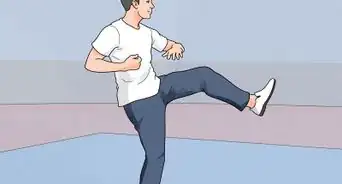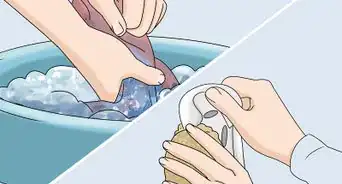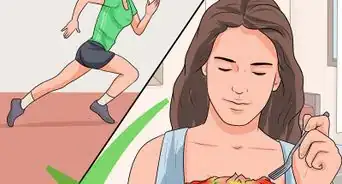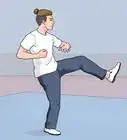This article was co-authored by wikiHow Staff. Our trained team of editors and researchers validate articles for accuracy and comprehensiveness. wikiHow's Content Management Team carefully monitors the work from our editorial staff to ensure that each article is backed by trusted research and meets our high quality standards.
This article has been viewed 94,613 times.
Learn more...
Kick ups, which is also known as keepie-uppies, is the practice of juggling a soccer ball with the feet, thighs, and head. It's a great way to practice ball control, and is a workout too. Winning in competitive kick ups with friends or teammates requires consistent practice and using techniques like watching the ball, getting into a cycle, and knowing where the ball is going to go. You can get good at the basics first, solidify your skills and style, and then focus yourself for the win.
Steps
Perfecting the Basics
-
1Bounce the ball on your thigh. Although soccer primarily uses the feet, beginners at kick ups should master using the thighs first because it's a bit easier than foot juggling. The ball should hit the flat surface of the thigh, not anywhere on the knee. Drop the ball to the thigh, bounce it once, and catch it. Do this for enough reps to get the motion down before going for multiple bounces.
-
2Use the bridge of your foot on the laces. When the thighs are mastered, incorporate the feet. Drop the ball and make contact with it where the toes start. Keep your toes pointed slightly up so that the ball bounces up rather than forward.
- If you straighten your toes out to point forward, the ball is more likely to bounce away from you.
- Start with one bounce at a time off your foot, making sure the ball goes straight up. When you get good at keeping the ball straight, go for more kicks in a row.
Advertisement -
3Start using your non-dominant foot. Most people have a dominant foot, and it's easier to let that foot do all the work, but the players who are best at kick ups will be equally strong with both feet. Once you get good with your dominant foot, begin practicing just as hard with your other foot.
- This will give your dominant foot a break during competitive kicks ups and give you more options to get a pattern going.
-
4Launch the ball up to your head, using either your foot or thigh. Kicking the ball with just the right amount of power up to your head is tricky and takes time to perfect. When you kick the ball into the air, it should be just out in front of your head so that you have to lean slightly forward to hit it. The ball should bounce off the flat part of your head rather than your forehead.
- Work to hit the ball straight up off your head rather than forward or backward.
- Moving the ball from your foot to your head may be a little easier than from your thigh to your head because you can get more power with your foot.
Building Your Kick Ups Skills
-
1Practice consistently. Beating others at kick ups means being consistently better than them, which is only achieved by practicing. You should practice kick ups techniques every day to build the strength in your legs and to form muscle memory for the motion juggling the ball takes. One way to practice is to set a certain time limit for which you must work on the skills, and then increase this time a little bit every day.
- Try to go for 10 seconds straight or for 10 reps without dropping the ball. Set a goal like this and then as you reach it, set a new, slightly higher goal.
-
2Find the motion that works best for you. Being comfortable with juggling will help you win kick ups more often, so if a certain way of moving feels better, do it that way. Some people like to move the foot at the ankle to pop the ball up, while others prefer slightly extending the knee to kick at the ball. You can even move your bent leg up and down at the hip.[1]
- Try using each approach for a few minutes and see which feels the most natural to you. Then get proficient at that style.
-
3Do drills to get the technique just right. You can't start out with the goal of getting 50 bounces on the first try. On a hard surface, bounce the ball off the ground and kick it up once into your hands. Drop it again and kick it twice, with a bounce in between, before catching it. Then kick it twice with no bounce and catch it. This progression will help get the exact motion right before going for too long.[2]
- You want the ball to go straight up after the kick without too much spin, so if you do one kick and it doesn't go straight up, stay on that step of the drill until you can kick it straight up. This gives you a foundation to build on.
- You can build on this basic drill by passing it from one foot to the other, going from foot to head back to thigh, or do 10 reps on the foot, then 10 on the thigh, then 10 on the head. The goal of drills is to get the technique right on a few reps before trying for the most reps.
Staying in the Zone
-
1Watch the ball. It may feel like keeping your eye on the ball makes you seem weak, but it is the most effective way to keep the ball going. You may think your foot or leg was positioned perfect for a pass up to your head, but watching the ball will help you know for sure. Where the ball goes will tell you whether or not you got the technique right.[3]
- You can practice juggling the ball without looking, to push yourself, but when you are playing to win, watching will give you an added edge on your opponent.
-
2Focus on your balance. Kick ups requires you to be on one foot for an extended period of time, so having exceptional balance is a useful aspect to master. If you are wobbling all over the place with each kick, you will have less control of where the ball goes. Work hard to maintain upright posture and only move enough to keep the ball moving.[4]
- A good way to practice is just standing on one foot for as long as you can, while staying up straight and not swaying. Once you can stand still for a long time, you'll be able to practice the movement of kicking.
-
3Move the ball through a pattern. Some people playing kick ups move the ball around at random and are constantly reacting to wherever the ball goes. You can win by having greater control than your opponent. Move the ball in a pattern, using each body part. If you move the ball in a pattern, you'll know exactly where it is going rather than guessing.[5]
- A good pattern might be right foot, left foot, left thigh, right thigh, head. Or you could go up the right side and down the left side by cycling right foot, right thigh, head, left thigh, left foot. The goal is planning ahead where you are passing the ball to.
Community Q&A
-
QuestionDo kick-ups strengthen your ball control and touch?
 Community AnswerThey do help improve your control of the ball, especially if the ball is in the air. They also help your coordination.
Community AnswerThey do help improve your control of the ball, especially if the ball is in the air. They also help your coordination.
References
- ↑ https://www.coachup.com/nation/articles/tips-on-improving-ball-control
- ↑ http://www.footy4kids.co.uk/soccer-drills/ball_control/juggling-and-keepy-uppies/
- ↑ https://www.myactivesg.com/sports/football/training-methods/develop-your-game/passing-and-control-drills
- ↑ http://www.soccercoachweekly.net/soccer-drills-and-skills/ball-control-and-footwork/coaching-tips-for-keepy-ups/
- ↑ http://www.soccer-training-info.com/juggling.asp

































































